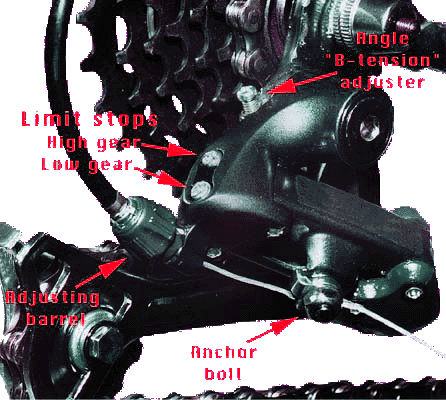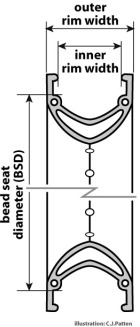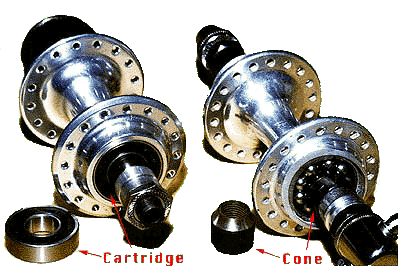Sheldon Brown's
Bicycle Glossary Ba - Bn

|
![]()
If the B-tension is too loose, however, the jockey pulley will bump into the largest rear sprocket, causing noisy running and possible shifting problems.
See my article on Derailer Adjustment for more information on this and other derailer adjustments.

![]()
![]()
 Bead
Bead The Bead Seat Diameter is the fundamental dimension used in the ISO/E.T.R.T.O. system of tire and rim sizing. This is the great virtue of that system, compared to all of the older systems that referred to the tire's outside diameter, with no specific reference to rim diameter or to the rim/tire interface.
Major bearings on a bicycle are the headset, the bottom bracket and the hubs. There are also bearings in brakes, pedals and freewheels.

Bearings used in bicycles are usually of the cup-and-cone type, but many newer bicycles use cartridge bearings.
Bearing balls are made in batches, and within a batch the size is very carefully controlled. From one batch to another, however, there can be a considerable variation in actual size of balls of the same nominal size. For this reason, balls from different batches should never be mixed in the same bearing.
Bearing balls come in several quality grades, designated by numbers. Grade 25 is the best that is available for bicycle applications. Grades 100, 200, even 300 are commonly used in bicycles.
![]()
![]()
 |
|
|---|---|
|
A bellcrank used to shift a
Sturmey-Archer 5-speed hub. |
Sheldon Brown points out a bellcrank that rings a bell,
Chevreuse, France, July, 1989. Photo by John Allen |
There are serious disadvantages to this approach, however:
As with shaft-drive systems, all of the benefits touted for this system are also attainable with an enclosed chain drive.
[Update, June 2012: Gates Carbon Drive carbon-fiber reinforced belts are currently in vogue. They don't stretch as much as other belts and so, don't have to be tensioned as much. However, carbon fiber is brittle, and these belts will soon snap if fibers have been damaged -- if the belt is "levered" onto a pulley from the side, or if a twig or trouser cuff is caught between the belt and a pulley. A Gates belt (and probably others) should be fitted over the pulleys loose, and tensioned by moving the pulleys farther apart, so the belt is subjected to stress only lengthwise, as in normal operation. -- John Allen]
Also see R&E Cycles comments on belt drive for the tandem synchronizing chain.
![]()
![]()
The Bike Boom was partly related to the Baby Boom, as Boomers were starting to enter adulthood in large numbers. Other factors were the popularization of 10-speed derailer-equipped bicycles, and increasing environmental awareness, with the hope that bicycling would substitute for much motoring. The bike boom is often attributed to the oil crisis of 1974, but in fact, it was already waning then -- see data in 1978 study republished by John Allen.
A similar bike boom had occurred in the mid-1890s when the safety bicycle with pneumatic tires replaced the high-wheeler.
It is important to distinguish bicycle sales from bicycle use. As bicycles are durable goods, a bike boom tends to saturate the market and then to be followed by a bust. The actual levels of bicycle use are more stable.*****

Binder bolts are also commonly used to clamp handlebars into the handlebar stem, and, in the case of threadless headsets, to clamp the stem to the fork steerer.
![]()
![]()
In the 1950's, some tire companies started using "gum" rubber (without the carbon black) for the sidewalls, in the interest of improved flexibility and lowered rolling resistance. Later, "skinwall" tires became popular, tires with nearly naked cloth sidewalls, with just a bit of rubber to hold the cords together. For many years, tan sidewalls, whether gum or skin, were a sign of high-performance tires, and blackwalls were a sign of cheapness.
In the early 1990s, there was a styling fad for tires which were basically skinwalls, but looked like the old blackwalls. Although the marketing departments of tire companies tried to make this out as some kind of advantage, it is fundamentally a styling issue, as with whitewalls.
Block chain had solid blocks as inner links, without rollers. It had a 1" pitch with 3/16" wide blocks, the same as the "skip link" roller chain that appeared on the market about 1930 to replace it.
The remaining stock of block chain was coveted by track riders who believed it was the only chain strong enough to withstand their imagined strength. When the stock of block chains finally ran out in the late 1970's, it was replaced by 1/2" pitch 3/32" wide chain, as used with derailers, although track riders still prefer a 1/8" wide chain, believing they are stronger than other riders. MTB's with 22 tooth granny chainwheels produce several times the chain tension any track rider can muster.

An 8-tooth sprocket for 1" pitch chain (left) is equivalent to a 16 for standard 1/2" chain.
![]()
![]()
![]()
Last Updated: by Harriet Fell